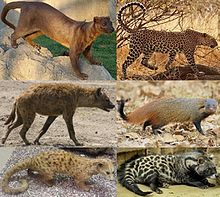Aeluroidea
| Aeluroidea Temporal range: Eocene–Holocene PreꞒ Ꞓ O S D C P T J K Pg N | |
|---|---|
 | |
| Scientific classification | |
| Domain: | Eukaryota |
| Kingdom: | Animalia |
| Phylum: | Chordata |
| Class: | Mammalia |
| Order: | Carnivora |
| Suborder: | Feliformia |
| Infraorder: | Aeluroidea |
| Subgroups | |
| |
Aeluroidea, Ailuroidea or Feloidea is the name of a taxon (infraorder or superfamily) comprising cat-like Carnivora. More specifically the taxon comprises:[1][2][3][4][5][6][7][8][9]
- either cat-like Carnivora in the broader sense, i. e. it is synonymous with Feliformia (more specifically either Feliformia sensu stricto, i. e. crown Feliformia, or Feliformia sensu lato, i. e. Pan-Feliformia);
- or cat-like Carnivora in the narrower sense, i. e. it comprises only the family Felidae (recently also Prionodontidae) and its closest extinct relatives.
The Aeluroidea in the first, i.e. broader sense, has been sometimes called infraorder Aeluroida since 1982.[10][11]The name Feloidea is sometimes used in a third sense - it designates the taxon corresponding to all Feliformia except the family Nandiniidae[6][12][13].
In the main system used in this wikipedia, the name Aeluroidea refers to the crown Feliformia (i. e. Feliformia sensu stricto) and has the rank of an infraorder, and Feloidea refers to the Felidae, Prionodontidae and their extinct closest relatives and has the rank of a superfamily.
Taxonomy of Aeluroidea
Aeluroidea was named by William Henry Flower in 1869 as one of two primary sections of the fissipedal Carnivora, the other section being the Arctoidea[14]. Since then, it has continued to be assigned to the Carnivora. Within Carnivora it is classified - depending on the author and the definition of the taxon (see above) - either as synonymous with Feliformia or as a part of Feliformia.[1][2][5][3][6][7][8]
Characteristics of Aeluroidea
Aeluroidea (in the sense of crown Feliformia) comprises species that are, or were, endemic to all continents except Antarctica and Australia, with domestic cats having been introduced to Australia.
Crown Feliformia (more specifically the Viverridae) are attested since the early Eocene, i. e. since about 50 million years ago; they are more frequently attested since the early Oligocene, i. e. since about 30 million years ago.[15]
References
- ^ a b Simpson, G.G. (1945). The Principles of Classification and a Classification of Mammals. American Museum of Natural History. Bulletin. American Museum of Natural History. p. 219, 220, 228, 115.
- ^ a b Rose, Kenneth D. (2005-03-29). The Rise of Placental Mammals. Baltimore: JHU Press. p. 185, 186, 179. ISBN 978-0-8018-8022-3.
- ^ a b Benton, Michael J. (2009-02-05). Vertebrate Palaeontology. John Wiley & Sons. p. 402. ISBN 978-1-4051-4449-0.
- ^ Bonis L. de, Ekrt B., Kunstmüllerová L., Martínek K., Rapprich V. & Wagner J. 2024. — New early aeluroid carnivoran (Mammalia, Carnivora, Feliformia) from the classical palaeontological locality Valeč, the Czech Republic. Geodiversitas 46 (1): 1-12. p. 4 [1]
- ^ a b Romer, Alfred Sherwood; Parsons, Thomas Sturges (1977). The Vertebrate Body. Philadelphia: W.B. Saunders Company. p. 571. ISBN 978-0-7216-7668-5.
- ^ a b c Feliformia, Pan-Feliformia. In: Queiroz, Kevin de; Cantino, Philip D.; Gauthier, Jacques A. (2020-04-30). Phylonyms. CRC Press. ISBN 978-0-429-82120-2.
- ^ a b R. L. Carroll. 1988. Vertebrate Paleontology and Evolution. W. H. Freeman and Company, New York 1-698
- ^ a b H. N. Bryant. 1991. Phylogenetic relationships and systematics of the Nimravidae (Carnivora). Journal of Mammalogy 72(1):56-78
- ^ Burgin, Connor & Widness, Jane & Upham, Nathan. (2020). Introduction to Illustrated Checklist of the Mammals of the World. 10.5281/zenodo.4270050. [2]
- ^ FLYNN, J. J., GALIANO, H. 1982. Phylogeny of early Tertiary Carnivora, with a description of a new species of Protictis from the middle Eocene of northwestern Wyoming. American Museum Novitates 2725:1-64
- ^ Feloidea. In: Paululat, A.; Purschke, G. (2011). Wörterbuch der Zoologie: Tiernamen, allgemeinbiologische, anatomische, physiologische, ökologische Termini (in German). Spektrum Akademischer Verlag. p. 186. ISBN 978-3-8274-2734-2.
- ^ "CARNIVORA (RAUBTIERE)". www.sthco.de. Retrieved 2024-09-06.
- ^ WIIG, O. (1985). Relationship of Nandinia binotata (Gray) to the Superfamily Feloidea (Mammalia, Carnivora). Zoologica Scripta, 14(2), 155–159
- ^ FLOWER, W. H. On the Value of the Characters of the Base of the Cranium in the Classification of the Order Carnivora, and on the Systematic Position of Bassaris and other Disputed Forms. Proceedings of the Scientific Meetings of the Zoological Society of London. 1869. p. 4 et seqq, specifically p. 22
- ^ "PBDB Taxon - Aeluroidea". The Paleobiology Database. 2005-08-26. Retrieved 2024-09-02.












